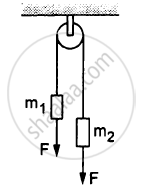Advertisements
Advertisements
प्रश्न
The position time graph of a body of mass 2 kg is as given in figure. What is the impulse on the body at t = 0 s and t = 4 s.

उत्तर
Given, the mass of the body (m) = 2 kg
From the position-time graph, the body is at x = 0 when t = 0, i.e., body is at rest.
∴ Impulse at t = 0, s = 0, is zero
From t =0 s to t = 4 s, the position-time graph is a straight line, which shows that body moves with uniform velocity.
Beyond t = 4 s, the graph is a straight line parallel to time ads, i.e., the body is at rest (v = 0).
The velocity of the body = slope of a position-time graph
= tan θ = `3/4` m/s
impulse (at t = 4 s) = change in momentum
= mv – mu
= m(v – u)
= `2(0 - 3/4)`
= `- 3/2` kg-m/s = – 1.5 kg-m/s
APPEARS IN
संबंधित प्रश्न
The below figure shows the position-time graph of a particle of mass 4 kg.
- What is the force on the particle for t < 0, t > 4 s, 0 < t < 4 s?
- What is the impulse at t = 0 and t = 4 s? (Consider one-dimensional motion only.)

When a horse pulls a cart, the force that helps the horse to move forward is the force exerted by
Two objects A and B are thrown upward simultaneously with the same speed. The mass of A is greater than that of B. Suppose the air exerts a constant and equal force of resistance on the two bodies.
In the following figure, m1 = 5 kg, m2 = 2 kg and F = 1 N. Find the acceleration of either block. Describe the motion of m1 if the string breaks but F continues to act.

A body of mass 5 kg is moving with velocity 2 m s-1. Calculate its linear momentum.
A force of 10 N acts on a body of mass 2 kg for 3 s, initially at rest. Calculate : The velocity acquired by the body
A ball is thrown vertically upwards. It returns 6 s later. Calculate : The greatest height reached by the ball . (Take g = 10 m s-2)
What do you mean by linear momentum of a body? A force causes an acceleration of 10 ms-2 in a body of mass 1 kg. What acceleration will be caused by the same force in a body of mass 4 kg?
A ball is thrown upward and reaches a maximum height of 19.6 m. Find its initial speed?
A body of mass 2 kg travels according to the law x(t) = pt + qt2 + rt3 where p = 3 ms−1, q = 4 ms−2 and r = 5 ms−3. The force acting on the body at t = 2 seconds is ______.
